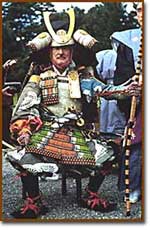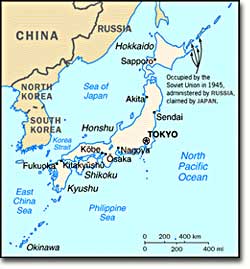
10. Japan: An Island Nation

Japan's samurai warriors had a strict code of conduct. They were the protectors of the Japanese people and the masters of the martial arts.
Japan is a land of contrasts.
Ultramodern skyscrapers tower over ancient shrines and temples. The latest styles from Paris or Milan are tastefully displayed alongside traditional silk kimonos. The high-speed Shinkansen bullet train thunders past a medieval castle that still looks fit enough to house a feudal lord and his devoted retainers.
Are these signs of a culture that cannot make up its mind? Hardly. Although high technology and modern conveniences have come to dominate Japanese life, the past is alive and well in the so-called Land of the Rising Sun.
But what's behind this sobriquet? Surprisingly, quite a lot. The name "Japan" (Nihon in Japanese) is a European mispronunciation of the Chinese term for "Land of the Sun's Origin," the old name by which the ancient Chinese referred to the islands lying to their east, the direction from which the sun seemed to rise.
The Archipelago

Although Japan is roughly the size of California, its geographical features are very different. The surrounding Sea of Japan and Pacific Ocean made foreign invasion difficult, while the mountains covering the land made unification on the island difficult as well.
Today, this chain of almost 7,000 large and small islands, collectively called the Japanese archipelago, sweeps down from the eastern tip of Siberia in the north to the northern edge of Taiwan in the south.
Comparing this impressive stretch to the lengthy eastern coast of the United States, Japan would extend from Maine to Miami. With a total land area that is slightly smaller than California, Japan is a very long but also very skinny country.
The largest and most notable parts of the island chain are the vast agricultural island of Hokkaidô, the main island of Honshû, the small but spirited island of Shikoku, the historically significant island of Kyûshû, and the tropical paradise of Okinawa.
As part of the volcanic Ring of Fire that encircles the Pacific Ocean, Japan has its share of volcanoes, earthquakes, and tsunami. Mountains define the lay of the land: 80 percent of the country is too mountainous to be suitable for agriculture.
Japan's rocky terrain impeded smooth transportation and easy communication among different parts of the land, especially in earlier times. These difficulties contributed to a sense of regionalism that later played a significant role in Japan's feudal period.
Perfect Proximity
Japan's location just off the fringe of continental Asia made it an ideal place for its unique culture to develop. The islands are situated close enough to China and Korea to benefit from the cultural and technological innovations of those great civilizations, but far enough removed across perilous seas to resist significant political and military domination from the two powers.
Japan has been commonly viewed as an isolated island nation with a single language and culture shared by a uniform population. From ancient times, though, Japan has been home to more than one ethnic group.
The Ainu, a race of Caucasoid peoples whose origins are still shrouded in mystery, settled a significant portion of the north.
Korean immigrants have been crossing the sea to reside in Japan ever since they learned the islands existed. Japan's rich history of cultural exchange is not limited to interactions with its Chinese and Korean neighbors. Since the 16th century C.E., Portuguese and Dutch visitors brought European trade and culture to the Japanese isles. This vibrant tradition of international commerce and communication significantly shaped Japan's history and culture.
So, what of this land where the ancient and the present collide every day? Pokémon and fuel-efficient cars are aspects of Japanese culture that can be seen in the modern world. But the ancient history of Japan reveals innovations and traditions that run much, much deeper.





